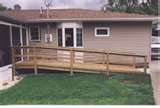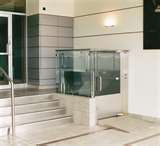The Wheelchair Guide
Your Wheelchair and Mobility Scooter Resource
Wheelchair Lifts vs Wheelchair Ramps
Thursday, September 9th, 2010 at 10:38 am
 In homes that have a staircase on the front access, it can be very difficult for wheelchair users to safely and conveniently get into and out of their home. There are a number of options available to help make this task easier, but in most cases, the wheelchair lift is the most effective and safest type of home mobility aid.
In homes that have a staircase on the front access, it can be very difficult for wheelchair users to safely and conveniently get into and out of their home. There are a number of options available to help make this task easier, but in most cases, the wheelchair lift is the most effective and safest type of home mobility aid.
Wheelchair Ramps
Traditionally, wheelchair ramps have been used to allow full access to a home. These are commonly seen on commercial buildings and often on homes as well. For non-commercial use, the most common type of wheelchair ramp is the wooden one, which is made in a manner similar to building a deck. There are a number of wheelchair ramp plans available and most capable contractors or handymen can build one, with most areas having companies that also specialize in custom wheelchair ramps. Generally, if you would not feel comfortable building your own deck, it is not a good idea to build a wooden wheelchair ramp.
In addition to wooden ramps, there are a number of pre-made metal ramps. Some of these are simple metal planks or threshold ramps, which are mainly used when there is only a step or two that must be navigated. For larger staircases, modular metal ramps are available, which come in sections and can be fitted together very easily.
While wheelchair ramps, at least wooden wheelchair ramps, are usually a good deal less expensive than a wheelchair lift, they can take up a lot of space. In the case of wooden ramps or modular ramps, it is not common for a significant amount of the front yard to be taken up by the wheelchair ramp. Smaller ramps, which are used when there is just a step or two, can make regular use of the staircase more difficult.
Wheelchair Lifts
 Wheelchair lifts are usually a more expensive option than building your own wooden wheelchair ramp, although modular -metal wheelchair ramps can get much more expensive and are often similar cost to a wheelchair lift. However, the added cost comes with a great deal more convenience and flexibility.
Wheelchair lifts are usually a more expensive option than building your own wooden wheelchair ramp, although modular -metal wheelchair ramps can get much more expensive and are often similar cost to a wheelchair lift. However, the added cost comes with a great deal more convenience and flexibility.
Wheelchair lifts, or vertical platform lifts, are basically a completely self-contained elevator unit, which is placed next to a staircase. Since the vertical platform lift is self-contained, there is no need to modify the home, such as you would need to do when building a residential elevator. Instead, the wheelchair lift can be placed directly next to the staircase and used to lift the user safely and quickly to the landing.
The biggest concern with an outdoor wheelchair lift is that the base that the unit sits on is well made and provides adequate drainage. A concrete base works best, although a wooden base can also be used, providing it is sturdy enough to support the weight of the vertical platform lift and its occupants.
It is also very important to consider things like overhanging branches, which could fall on the lift during a storm and damage it, as well as roof water run-off. In the case of the latter, it is very important that gutters are installed above the wheelchair lift and that ground water can not build up around the base of the device.
In addition to being easier to use, wheelchair lifts are installed on the side of a staircase, next to the landing. This means that full access to the steps will be maintained, with no obstructions.
Wheelchair Lifts and Interior Staircases
On interior staircases, a wheelchair lift is not always an option, as the lift must be installed next to the staircase’s landing. This is one of the reasons vertical platform lifts are often called “porch lifts,” as they are most often used on the front porch of a home.
For interior staircases, an inclined platform lift can sometimes be used, which provides a platform that moves along the length of the staircase, instead of vertically. These take up a lot of space though, so are more common on commercial stairways.